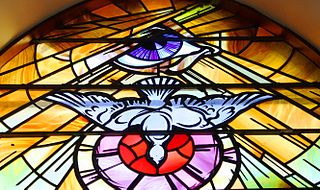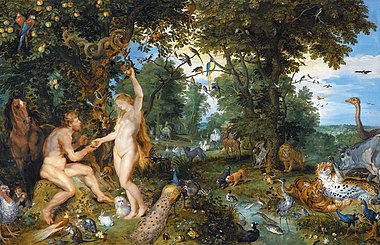
Original sin is the Christian doctrine that holds that humans, through the fact of birth, inherit a tainted nature with a proclivity to sinful conduct in need of regeneration. The biblical basis for the belief is generally found in Genesis 3, in a line in Psalm 51:5, and in Paul's Epistle to the Romans, 5:12-21.
Justificatio sola fide, meaning justification by faith alone, is a soteriological doctrine in Christian theology commonly held to distinguish the Lutheran and Reformed traditions of Protestantism, among others, from the Catholic, Eastern Orthodox, Oriental Orthodox, Assyrian and Anabaptist churches. The doctrine asserts that it is on the basis of faith alone that believers are made right of sin ; and not on the basis of what Paul the Apostle calls "works of the law", which sola fide proponents interpret as including not only moral, legal or ceremonial requirements but any good works or "works of charity."

Concupiscence is an ardent longing, typically one that is sensual. In Christianity, particularly in Catholic and Lutheran theology, concupiscence is the tendency of humans to sin.

In Western Christian theology, grace is created by God who gives it as help to one because God desires one to have it, not necessarily because of anything one has done to earn it. It is understood by Western Christians to be a spontaneous gift from God to people – "generous, free and totally unexpected and undeserved" – that takes the form of divine favor, love, clemency, and a share in the divine life of God. In the Eastern Orthodox Church, grace is the uncreated Energies of God. Among Eastern Christians generally, grace is considered to be the partaking of the Divine Nature described in 2 Peter 1:4 and grace is the working of God himself, not a created substance of any kind that can be treated like a commodity.
The Holiness movement is a Christian movement that emerged chiefly within 19th-century Methodism, and to a lesser extent influenced other traditions such as Quakerism, Anabaptism, and Restorationism. The movement is historically distinguished by its emphasis on the doctrine of a second work of grace, which is called entire sanctification or Christian perfection. Churches aligned with the holiness movement additionally teach that the Christian life should be free of sin. For the Holiness movement, "the term 'perfection' signifies completeness of Christian character; its freedom from all sin, and possession of all the graces of the Spirit, complete in kind." A number of evangelical Christian denominations, parachurch organizations, and movements emphasize those beliefs as central doctrine.
According to Catholicism and Lutheranism, a venial sin is a lesser sin that does not result in a complete separation from God and eternal damnation in Hell as an unrepented mortal sin would. A venial sin consists in acting as one should not, without the actual incompatibility with the state of grace that a mortal sin implies; they do not break one's friendship with God, but injure it.

A mortal sin, in Christian theology, is a gravely sinful act which can lead to damnation if a person does not repent of the sin before death. It is alternatively called deadly, grave, and serious; the concept of mortal sin is found in both Catholicism and Lutheranism. A sin is considered to be "mortal" when its quality is such that it leads to a separation of that person from God's saving grace. Three conditions must together be met for a sin to be mortal: "Mortal sin is sin whose object is grave matter and which is also committed with full knowledge and deliberate consent." The sin against the Holy Spirit and the sins that cry to Heaven for vengeance are considered especially serious. This type of sin is distinguished from a venial sin in that the latter simply leads to a weakening of a person's relationship with God. Despite its gravity, a person can repent of having committed a mortal sin. Such repentance is the primary requisite for forgiveness and absolution.

In Christian theology, justification is the event or process by which sinners are made or declared to be righteous in the sight of God.
Sanctification literally means "to set apart for special use or purpose", that is, to make holy or sacred. Therefore, sanctification refers to the state or process of being set apart, i.e. "made holy", as a vessel, full of the Holy Spirit of God. The concept of sanctification is widespread among religions, including Judaism and especially Christianity. The term can be used to refer to objects which are set apart for special purposes, but the most common use within Christian theology is in reference to the change brought about by God in a believer, begun at the point of salvation and continuing throughout the life of the believer. Many forms of Christianity believe that this process will only be completed in Heaven, but some believe that complete entire sanctification is possible in this life.
Semi-Pelagianism is a Christian theological and soteriological school of thought about the role of free will in salvation. In semipelagian thought, a distinction is made between the beginning of faith and the increase of faith. Semi-Pelagian thought teaches that the latter half – growing in faith – is the work of God, while the beginning of faith is an act of free will, with grace supervening only later. Semi-Pelagianism in its original form was developed as a compromise between Pelagianism and the teaching of Church Fathers such as Saint Augustine. Adherents to Pelagianism hold that people are born untainted by sin and do not need salvation unless they choose to sin, a belief which had been dismissed as heresy. In contrast, Augustine taught that people cannot come to God without the grace of God. Like pelagianism, semipelagianism was labeled heresy by the Western Church at the Second Council of Orange in 529.
According to Western Christianity, actual sin, as distinguished from original sin, is an act contrary to the will and law of God whether by doing evil or refraining from doing good. It can be either "mortal" or "venial".
Christian perfection is the name given to the process or the event of achieving spiritual maturity or perfection; it is a theological concept that exists within many denominations of Christianity. The ultimate goal of this process is union with God characterized by pure love of God and other people as well as personal holiness or sanctification. Other terms used for this or similar concepts include entire sanctification, perfect love, the baptism with the Holy Spirit, the indwelling of the Holy Spirit, baptism by fire, the second blessing, and the second work of grace.

As a general term in theological use, assurance refers to a believer's confidence in God, God's response to prayer, and the hope of eternal salvation. In Protestant Christian doctrine, the term "assurance", also known as the Witness of the Spirit, affirms that the inner witness of the Holy Spirit allows the Christian disciple to know that they are justified. Based on the writings of St. Augustine of Hippo, assurance was historically an important doctrine in Lutheranism and Calvinism, and remains a distinguishing doctrine of Methodism and Quakerism, although there are differences among these Christian traditions. Hymns that celebrate the witness of the Holy Spirit, such as Fanny Crosby's "Blessed Assurance", are sung in Christian liturgies to celebrate the belief in assurance.

The conservative holiness movement is a loosely defined group of theologically conservative Christian denominations with the majority being Methodists whose teachings are rooted in the theology of John Wesley, and a minority being Quakers (Friends) that emphasize the doctrine of George Fox, as well as River Brethren who emerged out of the Radical Pietist revival, and Holiness Restorationists in the tradition of Daniel Sidney Warner. Schisms began to occur in the 19th century and this movement became distinct from parent Holiness bodies in the mid-20th century amid disagreements over modesty in dress, entertainment, and other "old holiness standards" reflective of the related emphases on the Wesleyan–Arminian doctrine of outward holiness or the Quaker teaching on the testimony of simplicity or the River Brethren and Restorationist teachings on nonconformity to the world, depending on the denomination. Christian denominations aligned with the conservative holiness movement share a belief in Christian perfection, though they differ on various doctrines, such as the celebration of the sacraments and observance of ordinances, which is related to the denominational tradition—Methodist, Quaker, Anabaptist or Restorationist. Many denominations identifying with the conservative holiness movement, though not all, are represented in the Interchurch Holiness Convention; while some denominations have full communion with one another, other bodies choose to be isolationist.

Imputed righteousness is a concept in Christian theology proposing that the "righteousness of Christ...is imputed to [believers]—that is, treated as if it were theirs—through faith." It is on the basis of Jesus' righteousness that God accepts humans. This acceptance is also referred to as justification.
In Christian theology, good works, or simply works, are a person's (exterior) actions and deeds that align with the moral teachings, emphasizing compassion, charity, kindness and adherence to biblical principles, in contrast to inner qualities such as grace or faith. Rooted in the belief that faith should manifest in positive actions, the concept underscores the importance of living out one's faith through generosity. Adherents emphasize the significance of engaging in altruism as a demonstration of their devotion to God. These actions, guided by the moral and ethical teachings of the Bible, are viewed as tangible expressions of love, obedience and righteousness within the framework of the Christian worldview. The concept of good works is intricately linked to the theological belief in salvation through faith rather than a means of earning salvation, as Christians seek to manifest their gratitude for God's grace by actively participating in acts of service to others. This theological perspective places significance on the transformative power of good works in fostering a life reflective of Christian values. Christians are often encouraged to love their neighbors, care for the unfortunate, and promote moral values in their communities.

Wesleyan theology, otherwise known as Wesleyan–Arminian theology, or Methodist theology, is a theological tradition in Protestant Christianity based upon the ministry of the 18th-century evangelical reformer brothers John Wesley and Charles Wesley. More broadly it refers to the theological system inferred from the various sermons, theological treatises, letters, journals, diaries, hymns, and other spiritual writings of the Wesleys and their contemporary coadjutors such as John William Fletcher.

According to some Christian traditions, a second work of grace is a transforming interaction with God which may occur in the life of an individual Christian. The defining characteristics of the second work of grace are that it is separate from and subsequent to the New Birth, and that it brings about significant changes in the life of the believer.
Protestant theology refers to the doctrines held by various Protestant traditions, which share some things in common but differ in others. In general, Protestant theology, as a subset of Christian theology, holds to faith in the Christian Bible, the Holy Trinity, salvation, sanctification, charity, evangelism, and the four last things.

Catholic hamartiology is a branch of Catholic thought that studies sin. According to the Catholic Church, sin is an "utterance, deed, or desire," caused by concupiscence, that offends God, reason, truth, and conscience. The church believes sin is the greatest evil and has the worst consequences for the sinner, the world, and the l Catholic Church itself. Based on the Bible, the Catholic Church distinguishes between two kinds of sins: mortal sin and venial sin. The Catholic Church also distinguishes between the state of being in original sin and the commission of actual sin.












